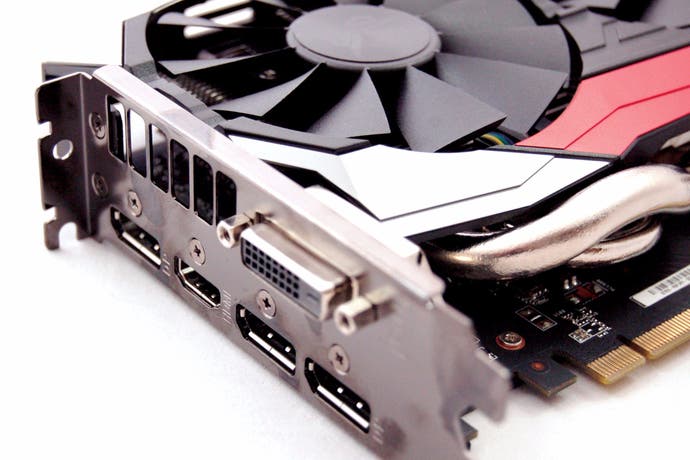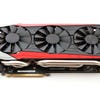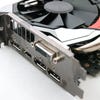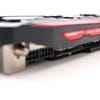AMD Radeon R9 Fury review
Too fast, too furious?
With AMD's Radeon R9 Fury X, the red team promised us the fastest single-chip GPU on the market, but the final product didn't quite live up to the hype. An intriguing cooling solution, a small form-factor and state of the art memory tech gave Fury X some unique properties, but Nvidia had outmanoeuvred AMD on overall performance with its GeForce GTX 980 Ti. However, the new cut-down, air-cooled R9 Fury (the non-X edition, if you will) is an interesting proposition: inevitably, it will be slower, but at the mooted $550 sticker price, Nvidia has no real alternative at the same price. AMD is marketing this as a GTX 980 beater - more expensive, but faster overall. Of course, the reality is a little more complex than that, but the strategy is sound: AMD wants to carve out and own a new niche for the Fury.
At its core, the air-cooled R9 Fury is indeed a cut-down version of the existing Fury X. At an architectural level, it's the same Fiji chip at the heart of the design, but there's a 12.5 per cent drop in shader count - 4096 stream processors become 3584 - while clock-speed drops from Fury X's 1050MHz to a round 1000MHz on the new card. Texture mapping units are reduced from 256 to 224, but otherwise this pared back Fiji Pro chip is much the same as the top-end Fiji XT found in Fury X.
However, in purely physical terms, the new Fury is an entirely different proposition. The short, 7.5-inch PCB for the Fury X is gone, replaced by a full-size board combined with a top-tier cooling solution. The Fiji processor is large, and while it's not the hottest, most power-hungry chip in AMD's line-up (that honour goes to the overclocked Hawaii found in the Radeon R9 390X), it's clear that the firm is taking no chances in making sure that Fiji is kept cool. The closed loop water-cooler is gone, but the alternative - premium-level heat-sinks and fans from Sapphire and Asus - are still effective in making sure that we don't find ourselves facing another overheating Hawaii situation. Throughout our testing, we never saw the Fury shift under load from its target 1000MHz boost clock, so there's no thermal throttling here and Asus' DirectCU 3 cooler is beautifully quiet - even under full load (and there's no 'coil whine' either - though in point of fact, Asus tells us that this noise tends to comes from the onboard chokes).
Just like its more powerful sibling, the R9 Fury requires two eight-pin power supply inputs, but video outputs are actually improved over the Fury X - the three DisplayPorts and HDMI are retained, but we also get the dual-link DVI interface removed from the top-tier Fiji offering. Most monitors ship with all three types of input these days, so losing DVI on the Fury X wasn't a deal-breaker, but more options are always very welcome.
- Order the Radeon R9 Fury 4GB from Amazon with free shipping
Diving head-first into performance, we deploy the new card against the GTX 980 and Fury X in our Crysis 3 gameplay challenge - the aim here being to produce a top-end, tear-free, maxed-out experience at 1440p at as close to 60fps as possible. Crytek's 2013 tech showcase used to be the best stress test available for PC gaming hardware, but these days its function has changed. It's more of barometer for how a good, scalable, well-optimised game should operate.
Generally speaking, it's our belief that the best PC gameplay experience comes from matching both resolution and frame-rate to the specs of your display - though a 50-60fps variance still hands in superlative results on G-Sync or FreeSync monitors. There's an argument that the R9 Fury is more of a 4K card (and as previously demonstrated, you can definitely get some good results there on certain titles), but bearing in mind that even the full-fat Fury X fell short of hitting 60fps - even with compromised quality settings - we opted for 1440p instead for this initial test.
By and large, it's an instinct that pays off. The uncompromised Fury X makes a good fist of sustaining the action at this extreme level, but in this title at least, the cut-down card is noticeably slower. However, the good news from AMD's perspective is that there's still a large leap in performance over the GTX 980 - the new Fury sits somewhere in-between Fury X and GTX 980 in like-for-like sequences. The question is, will that level of enhanced performance over its nearest Nvidia competitor extend into a large range of games?
| Crysis 3 1440p V-Sync Gameplay | R9 Fury | R9 Fury X | GTX 980 |
|---|---|---|---|
| Lowest Frame-Rate | 36.0fps | 40.0fps | 31.0fps |
| Dropped Frames (from 18650 total) | 2084 (11.17%) | 1141 (6.12%) | 3852 (20.66%) |
Order the graphics cards tested against the R9 Fury from Amazon, with free shipping:
We'll start by taking a close look at the Fury's performance at its performance sweet spot - 4K ultra-HD resolution. Challenging releases like Crysis 3 are still a long way off hitting a locked 60fps, even with significantly pared back quality settings, but other games aren't quite so taxing on hardware and the new range of 'uber' GPUs can perform really well here, as long as you don't go crazy with ultra level settings or utilise multi-sampling anti-aliasing. Here we find that the Fury commands a pretty convincing advantage over the GTX 980 and overclocking sees it match the higher-end Fury X in seven out of eight of our test titles.
In terms of the comparisons that matter, the R9 Fury is 18 per cent faster on aggregate than the GTX 980 at 4K - with AMD-friendly games like Ryse and Shadow of Mordor seeing that rise substantially to 20 to 30 per cent. We've also included some data we have from a factory-overclocked GTX 980 (MSI's Gaming 4G model). We're missing Witcher benches here, but that doesn't really matter - the fact is that the 980 just doesn't scale well at 4K. Comparisons with the Fury X are also compelling. It may be $100 cheaper, but we're seeing 93 per cent of the raw performance and via overclocking we almost achieve parity with the flagship - only the 2013 Tomb Raider reboot sees a small performance deficit. This suggests that most titles benefit more from higher clocks and that perhaps there's diminishing returns from the stream processor count.
Ultra HD is the area where Fiji cards like Fury and Fury X are at their best, but it can still be a struggle to maintain high frame-rates in some games, and that's not exactly surprising. Let's not forget that the pixel count here is the equivalent of running four 1080p screens simultaneously from one graphics card. According to the Steam hardware survey, 4K gaming barely registers amongst the user base, so it stands to reason that the R9 Fury needs to be more flexible to gain a foothold in the market - it needs to comprehensively beat the other options at 1440p resolution and lower.
| 3840x2160 (4K) | R9 390X | GTX 980 | MSI GTX 980 | Titan X | GTX 980 Ti | R9 Fury X | R9 Fury | R9 Fury (OC) |
|---|---|---|---|---|---|---|---|---|
| The Witcher 3, High, HairWorks Off, Custom AA | 29.1 | 27.7 | N/A | 37.5 | 36.9 | 36.2 | 33.1 | 35.5 |
| Battlefield 4, High, Post-AA | 44.5 | 46.8 | 47.0 | 61.3 | 61.0 | 51.0 | 47.7 | 51.0 |
| Crysis 3, High, SMAA | 40.2 | 39.0 | 39.4 | 52.4 | 52.5 | 49.2 | 45.6 | 48.9 |
| Assassin's Creed Unity, Very High, FXAA | 22.7 | 21.8 | 22.2 | 27.4 | 26.5 | 25.3 | 23.0 | 25.0 |
| Far Cry 4, Very High, SMAA | 44.4 | 36.1 | 36.9 | 46.7 | 47.1 | 50.5 | 47.3 | 50.9 |
| Ryse: Son of Rome, Normal, SMAA | 37.8 | 31.5 | 31.8 | 42.2 | 41.7 | 44.0 | 40.9 | 43.6 |
| Shadow of Mordor, High, High Textures, FXAA | 50.1 | 42.4 | 42.1 | 54.8 | 54.8 | 55.5 | 51.6 | 55.4 |
| Tomb Raider, Ultra, FXAA | 51.4 | 47.1 | 36.9 | 64.6 | 61.3 | 63.9 | 55.5 | 60.0 |
At 2560x1440, the R9 Fury is still compelling, though it does face its fair share of challenges. On aggregate, it is just 8.5 per cent faster than the reference GTX 980, but the scale of its wins on a per-game basis varies dramatically, from the single percentage point uplift (!) in Assassin's Creed Unity through to the impressive 19.7 per cent boost found in Ryse: Son of Rome. MSI's factory overclocked GTX 980 reverses a clutch of the reference card's narrow defeats too: it is faster in Battlefield 4 and AC Unity and just one per cent behind in Tomb Raider. Unfortunately, we don't have benchmarks from The Witcher 3 (we snuck out these benches on our test system when we reviewed this), but the factory overclock should put it into contention there too.
Additional competition for the Fury actually comes from AMD itself too in the form of the Radeon R9 390X - our benches here coming from the mildly overclocked MSI version we previously reviewed. The Fury is 12 per cent faster in The Witcher 3 and 11 per cent faster in Crysis 3, but other boosts are more limited, and across our eight test games, the R9 Fury is just seven per cent faster on average. That's food for thought bearing in mind that the sticker price for the 390X is around £100 lower, and it comes with twice the memory.
This places the R9 Fury into something of a difficult situation - it loses some of its competitiveness at 1440p, while there's the feeling that there's not quite enough oomph to make it good enough to run all games at high frame-rates at 4K. GTX 980 is a lot more power-efficient and easier to cool, while the R9 390X results must surely be a little uncomfortable for AMD bearing in mind the price and RAM differentials. On the plus side however, the air-cooled Fury is still competitive with its bigger brother: compared to the top-tier Fury X, it's still around 92 per cent as fast on average and once again, overclocking makes up almost all of the difference in most scenarios.
| 2560x1440 (1440p) | R9 390X | GTX 980 | MSI GTX 980 | Titan X | GTX 980 Ti | R9 Fury X | R9 Fury | R9 Fury (OC) |
|---|---|---|---|---|---|---|---|---|
| The Witcher 3, Ultra, HairWorks Off, Custom AA | 43.5 | 47.5 | N/A | 63.3 | 61.7 | 52.4 | 48.8 | 51.7 |
| Battlefield 4, Ultra, 4x MSAA | 54.5 | 57.0 | 59.6 | 76.1 | 75.0 | 62.2 | 58.2 | 62.2 |
| Crysis 3, Very High, SMAA | 52.3 | 50.0 | 53.7 | 68.0 | 66.2 | 63.4 | 58.0 | 61.9 |
| Assassin's Creed Unity, Ultra High, FXAA | 38.4 | 39.7 | 41.1 | 49.6 | 48.3 | 45.8 | 40.1 | 42.7 |
| Far Cry 4, Ultra, SMAA | 69.0 | 61.3 | 65.6 | 77.0 | 75.4 | 78.9 | 73.4 | 78.7 |
| Ryse: Son of Rome, High, SMAA | 62.2 | 54.1 | 57.9 | 72.8 | 71.2 | 71.4 | 64.8 | 68.4 |
| Shadow of Mordor, Ultra, High Textures, FXAA | 74.4 | 66.0 | 68.9 | 87.2 | 87.2 | 82.5 | 77.7 | 82.8 |
| Tomb Raider, Ultimate, FXAA | 75.6 | 76.7 | 81.0 | 101.9 | 99.2 | 91.6 | 81.8 | 85.9 |
Last but not least, we come to our 1080p testing. It's safe to say that the R9 Fury isn't designed for such a relatively meagre resolution, but then agin, neither is the GTX 980 Ti - and yet it still posts a 20-25 per cent improvement in overall performance, depending on which model of GTX 980 you're comparing it to. Full HD remains the most popular gaming resolution according to the Steam hardware survey, and we think that ignoring this - as many reviews have - doesn't really do potential buyers any favours. High refresh rate monitors and stereo 3D are two good applications for a high-end GPU like this running at 1080p, so the metrics are valid.
The bottom line is that even the reference GTX 980 is highly competitive against the R9 Fury, to the point where The Witcher 3 and Assassin's Creed Unity are both eight per cent faster on the cheaper, less capable card. AMD favourites Ryse and Shadow of Mordor save some face (11 per cent and 12 per cent faster than GTX 980 respectively), but the bottom line is that half of the games we tested are faster on the cheaper Nvidia card at full HD, on reference clocks no less. And once again, the R9 390X comes into contention too - only The Witcher 3 and Crysis 3 show much scaling on Fury at nine and 11 per cent respectively. Otherwise, it's much of a muchness between the two AMD offerings.
There have been theories that AMD's slower DX11 driver may be to blame for the poor showings at lower resolutions. However, if that were the case, we would expect Fury and Fury X to perform at the same level at 1080p and 1440p as CPU would become the bottleneck rather than the GPU hardware - this does not happen: the top-tier card is still faster and once again, overclocking brings us pretty close to overall parity. Curiously, we actually find that Far Cry 4 is faster on Fury than it was when we tested it on Fury X - substantially so, in fact. We must assume a fault of some kind in our test, or an optimisation in the 15.7 driver vs the 15.15 we had to test with the Fury X. That result always looked strange, but we re-ran the 1080p benches at the time to confirm the scalability issues with the same result, while the same PC was used to bench the new Fury. Unfortunately we can't re-test the Fury X at this time as press samples in the UK are highly limited and unfortunately, we had to return our unit.
| 1920x1080 (1080p) | R9 390X | GTX 980 | MSI GTX 980 | Titan X | GTX 980 Ti | R9 Fury X | R9 Fury | R9 Fury (OC) |
|---|---|---|---|---|---|---|---|---|
| The Witcher 3, Ultra, HairWorks Off, Custom AA | 57.4 | 65.8 | N/A | 84.4 | 82.6 | 67.1 | 62.8 | 66.5 |
| Battlefield 4, Ultra, 4x MSAA | 78.3 | 86.5 | 89.6 | 112.4 | 109.9 | 86.9 | 81.3 | 87.0 |
| Crysis 3, Very High, SMAA | 80.1 | 81.5 | 85.9 | 105.2 | 104.0 | 94.3 | 88.5 | 93.7 |
| Assassin's Creed Unity, Ultra High, FXAA | 56.0 | 62.4 | 62.6 | 74.7 | 74.4 | 62.8 | 57.3 | 61.2 |
| Far Cry 4, Ultra, SMAA | 82.4 | 87.4 | 92.0 | 101.4 | 101.2 | 81.5 | 80.6 | |
| Ryse: Son of Rome, High, SMAA | 81.8 | 75.8 | 80.4 | 99.2 | 97.8 | 85.1 | 84.1 | 85.1 |
| Shadow of Mordor, Ultra, High Textures, FXAA | 101.9 | 91.7 | 95.9 | 119.0 | 118.5 | 110.2 | 102.7 | 110.0 |
| Tomb Raider, Ultimate, FXAA | 107.1 | 118.2 | 123.8 | 150.1 | 150.3 | 127.4 | 114.1 | 122.4 |
We complete our testing with a look at power consumption on the R9 Fury and the major comparison products - Fury X, GTX 980 and GTX 980 Ti. To do this we relocate our gameplay to the end of Crysis 3's Welcome to the Jungle stage. At this point, the level is set ablaze via the enemy's 'napalm choppers' and the combination of highly detailed jungle scenery along with generous lashings of alpha transparencies sees every GPU we've tested produce an extraordinary power load - significantly higher than standard gameplay. It's good for testing the stability of overclocking as well as the peak level of juice your system draws from the wall.
The tests throw up few surprises - at stock clocks, the R9 Fury is 50MHz slower than the Fury X, so we see a slight reduction in overall power consumption. However, with the overclock in place, we're running the Fiji chip a touch faster than its big brother, and thus the amount of energy taken from the mains inches ahead. Nvidia still retains its power-efficiency crown: the GTX 980 consumes over 100W less than the R9 Fury at full pelt and the much more powerful GTX 980 Ti also commands a lead over the Fiji products. However, bearing in mind how far ahead Nvidia has been in this area, the fact that both Fury and Fury X only consume around 30W more than the equivalent GTX 980 Ti with comparable performance shows that the red team are catching up in this important area.
Improved power efficiency is obviously good for the planet (let's be honest, you're unlikely to notice the difference on your electricity bill unless you're sinking a huge amount of hours into gaming) but it has more practical applications in terms of lower heat generation. Generally speaking, the cooler your PC operates, the better. Ensuring good airflow in the chassis is a must, but obviously the job gets easier if your components are producing less heat in the first place.
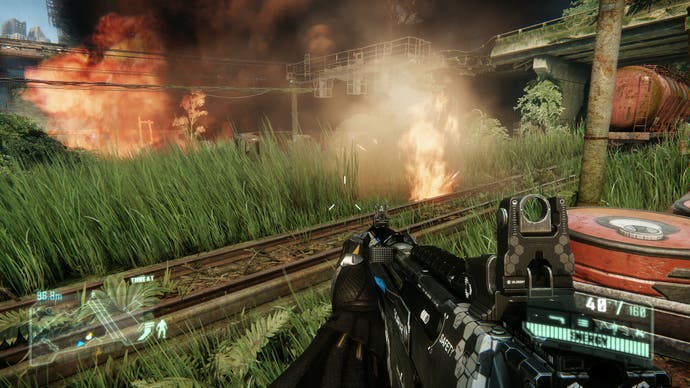
| R9 Fury | R9 Fury (OC) | R9 Fury X | GTX 980 | GTX 980 Ti | |
|---|---|---|---|---|---|
| Peak System Power Draw | 392W | 404W | 407W | 281W | 375W |
AMD Radeon R9 Fury: the Digital Foundry verdict
If you're looking for the cheapest single-chip GPU that can run a good proportion of games well at 4K resolution, the Radeon R9 Fury is a quality purchase. It's not far off the pace set by its bigger brother and it can be overclocked to match in most titles, adding further to its value. However, just like the Fury X, the law of diminishing returns kicks in at lower resolutions and that is a concern. This isn't designed to be a 1080p card, but it remains the most popular gaming resolution on the market - and both Furies come up short here compared to the Nvidia offerings. At 1440p, the Fury is generally faster than the GTX 980, but the Nvidia card is close in some titles - perhaps too close for comfort. Meanwhile, the R9 390X we previosly tested isn't that much slower than the new Fury at 1440p, it's a lot cheaper and comes with 8GB of RAM.
In the US, pricing is seemingly crystal clear: the GTX 980 costs $500, the R9 Fury costs $550. There's a 10 per cent price premium that buys you competitive 1440p performance, plus a substantial increase in frame-rates for 4K gameplay. However, in the UK, our current understanding is that the air-cooled Fury will retail for £450, and that's a concern when the GTX 980 is currently £90 less in several outlets. With that in mind, the balance changes - suddenly the Nvidia's superior 1080p performance, its decent 1440p results and enviable overclocking potential suddenly look more attractive when you're paying 20 per cent less for the product. Even high-end factory overclocked versions of the GTX 980 - like the MSI Gaming 4G model - command a significant value advantage over a prospective £450 Fury. Launch pricing is always rather murky: market forces tend to sort things out sooner or later, but in the meantime, our gut feeling right now is that the Fury is a bit too expensive for UK buyers, but well-priced for our transatlantic cousins.
The R9 Fury is definitely an interesting product then, but perhaps not a game-changer. We like the fact that AMD has managed to carve out its own niche in the market for the pared back Fiji - it's an astute move. In this case, its strength lies in finding a new price-point where Nvidia has no real alternative, but going forward, the upcoming Fury Nano is all about making the most of HBM's form-factor advantages - and the idea of a class-leading small form-factor GPU is compelling. And that all sounds rather exciting to us: new, practical applications for cutting-edge technology is just as appealing - perhaps even more so - than a strategy vision centred on entirely on furthering the fps arms race.
